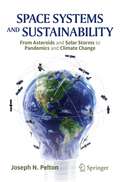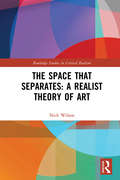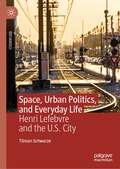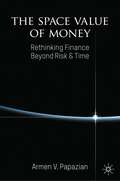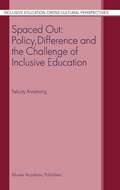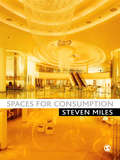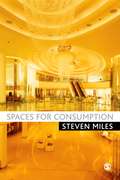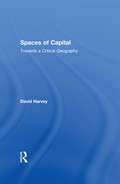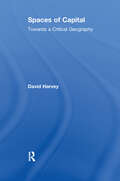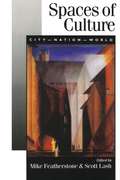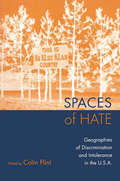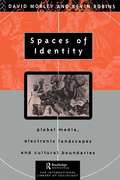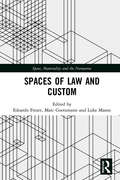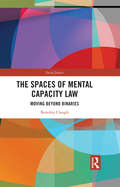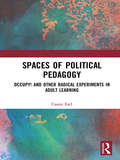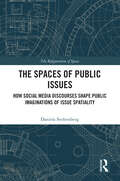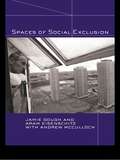- Table View
- List View
Space Systems and Sustainability: From Asteroids and Solar Storms to Pandemics and Climate Change
by Joseph N. PeltonIn his latest book, space scientist, futurist, and educator Joseph N. Pelton explores adozen ways that Planet Earth is at “existential” risk, along with the many ways thatspace systems, data analytics, and advanced networking systems can help us copewith these global challenges.The chapters examine in a straightforward way how satellite systems and technol-ogy can drastically transform fields such as pandemic tracking and global medicalresponses, cosmic hazard monitoring, nuclear energy and waste disposal, water andland pollution, tele-education/telemedicine, and military conflict. Such examplesshow how orbiting smart systems will play an ever more vital role in our vulnerablemodern world, allowing us to monitor, track, and respond to mounting problems ofthe 21st century.Dr. Pelton takes a broad view, probing the social, economic, and regulatory factorsthat are crucial to creating a more sustainable “Spaceship Earth.” This book is a callto action, promoting more organized international collaboration and investment in space technologies that can enable global change.
The Space that Separates: A Critical Realist Aesthetics (Routledge Studies in Critical Realism)
by Nick WilsonThe Space that Separates: A Realist Theory of Art radically challenges our assumptions about what art is, what art does, who is doing it, and why it matters. Rejecting the modernist and market-driven misconception that art is only what artists do, Wilson instead presents a realist case for living artfully. Art is defined as the skilled practice of giving shareable form to our experiences of being-in-relation with the real; that is to say, the causally generative domain of the world that extends beyond our direct observation, comprising relations, structures, mechanisms, possibilities, powers, processes, systems, forces, values, ways of being. In communicating such aesthetic experience we behold life’s betweenness – "the space that separates", so coming to know ourselves as connected. Providing the first dedicated and comprehensive account of art and aesthetics from a critical realist perspective – Aesthetic Critical Realism (ACR), Wilson argues for a profound paradigm shift in how we understand and care for culture in terms of our system(s) of value recognition. Fortunately, we have just the right tool to help us achieve this transformation – and it’s called art. Offering novel explanatory accounts of art, aesthetic experience, value, play, culture, creativity, artistic truth and beauty, this book will appeal to a wide audience of students and scholars of art, aesthetics, human development, philosophy and critical realism, as well as cultural practitioners and policy-makers.
The Space that Separates: A Critical Realist Aesthetics (Routledge Studies in Critical Realism)
by Nick WilsonThe Space that Separates: A Realist Theory of Art radically challenges our assumptions about what art is, what art does, who is doing it, and why it matters. Rejecting the modernist and market-driven misconception that art is only what artists do, Wilson instead presents a realist case for living artfully. Art is defined as the skilled practice of giving shareable form to our experiences of being-in-relation with the real; that is to say, the causally generative domain of the world that extends beyond our direct observation, comprising relations, structures, mechanisms, possibilities, powers, processes, systems, forces, values, ways of being. In communicating such aesthetic experience we behold life’s betweenness – "the space that separates", so coming to know ourselves as connected. Providing the first dedicated and comprehensive account of art and aesthetics from a critical realist perspective – Aesthetic Critical Realism (ACR), Wilson argues for a profound paradigm shift in how we understand and care for culture in terms of our system(s) of value recognition. Fortunately, we have just the right tool to help us achieve this transformation – and it’s called art. Offering novel explanatory accounts of art, aesthetic experience, value, play, culture, creativity, artistic truth and beauty, this book will appeal to a wide audience of students and scholars of art, aesthetics, human development, philosophy and critical realism, as well as cultural practitioners and policy-makers.
Space, Urban Politics, and Everyday Life: Henri Lefebvre and the U.S. City
by Tilman SchwarzeThis Book develops a novel and innovative methodological framework for operationalising Henri Lefebvre’s work for empirical research on the U.S. city. Building on ethnographic research on Chicago’s South Side, Tilman Schwarze explores the current situation of urbanisation and urban life in the U.S. city through a critical reading and application of Lefebvre’s writings on space, everyday life, the urban, the state, and difference. Focusing on territorial stigmatisation, public housing transformation, and urban redevelopment, this book makes an important contribution to critical urban scholarship, foregrounding the relevance and applicability of Henri Lefebvre’s work for geographical and sociological research on urban politics and everyday life.
The Space Value of Money: Rethinking Finance Beyond Risk & Time
by Armen V. PapazianThe Space Value of Money introduces a fresh and innovative perspective on sustainability and finance. It expands our financial value framework, heretofore built around risk and time, by factoring in space, as an analytical dimension and our physical context. The proposed principle and metrics entrench our responsibility for space impact into our value equations, making finance inherently sustainable and acting as a theoretical bridge between core finance theory and the growing field of sustainable finance or ESG integration. The book offers a novel approach to value design, measurement, and creation, discussing the theoretical, mathematical, institutional, technological and data elements of the transformation.The Space Value of Money principle and metrics offer us the opportunity to adjust our financial value framework and transform human productivity in line with our sustainability targets. They also enable the design and engineering of the financial instruments that can help us address our evolutionary challenges/investment, like the transition to Net Zero.“Every once in a while, a book comes along that makes a fundamental contribution that is both profound and practical. A book that every member of the National Space Council, including the NASA Administrator and the Space Force chief of space operations should read. The Space Value of Money will be of interest to ESG and impact investors, government regulators, financial theorists, and outer space enthusiasts.” —Lt Col Peter Garretson, Senior Fellow in Defense Studies at the American Foreign Policy Council“No doubt, the pressing environmental challenges we face make the concept of the space impact of investments even more compelling.” —Dr. Pascal Blanqué, Chairman of Amundi Institute, Former Group CIO of Amundi Asset Management“The Space Value of Money brings much needed conceptual rigour, whilst further advocating the case for a new paradigm shift in financial valuation. This work gives us the lasting frameworks that aggregate impact across all spatial dimensions. Dr. Papazian culminates over ten years of research in this rich book, providing the springboard for further innovation and system implementation in this area.” —Domenico Del Re, Director, Sustainability and Climate Change, PwC“Enthralling and captivating. Papazian offers a clear, thorough, and comprehensive discussion. The Space Value of Money gives us an opportunity to reframe our thinking and to explore what is possible. A great read!” —Daud Vicary, Founding Trustee of the Responsible Finance and Investment Foundation“Armen has developed a novel way to create financial models that are better suited to dealing with the many parameters required if we are to properly consider environmental factors and sustainability in economics and finance. I have found this engaging and look forward to seeing its future use.” —Dr. Keith Carne, First Bursar, King’s College, Cambridge University
Spaced Out: Policy, Difference and the Challenge of Inclusive Education (Inclusive Education: Cross Cultural Perspectives #1)
by F. ArmstrongThis work contributes to teachers’ and academic researchers’ understanding of the varied and complex ways inclusion and exclusion can be understood. It provides a lucid, coherent analysis into the nature of categorization, labeling and discursive practices within official discourse and procedures as well as the positional relationships between space, place and identities in relation to the experience of marginalized people including disabled pupils and young people.
Spaces for Consumption
by Steven MilesIn Spaces for Consumption Steven Miles develops a penetrating critique of a key shift characterising the contemporary city. Theoretically informed, the other strength of the volume lies in the wealth of examples that are drawn upon to show how cities are becoming spaces for consumption, which has itself rapidly become a global phenomenon." - Ronan Paddison, University of Glasgow "This is a great book. Powerfully written and lucid, it provides a thorough introduction to concepts of consumption as they relate to the spaces of cities. The spaces themselves - the airports, the shopping malls, the museums and cultural quarters - are analysed in marvellous detail, and with a keen sense of historical precedent. And, refreshingly, Miles doesn't simply dismiss cultures of consumption out of hand, but shows how as consumers we are complicit in, and help define those cultures. His book makes a major contribution to our understanding of contemporary cities, but is accessible enough to appeal to any reader with an interest in this important area." - Richard Williams, Edinburgh University Spaces for Consumption offers an in-depth and sophisticated analysis of the processes that underpin the commodification of the city and explains the physical manifestation of consumerism as a way of life. Engaging directly with the social, economic and cultural processes that have resulted in our cities being defined through consumption this vibrant book clearly demonstrates the ways in which consumption has come to play a key role in the re-invention of the post-industrial city The book provides a critical understanding of how consumption redefines the consumers' relationship to place using empirical examples and case studies to bring the issues to life. It discusses many of the key spaces and arenas in which this redefinition occurs including: shopping themed space mega-events architecture Developing the notion of 'contrived communality' Steven Miles outlines the ways in which consumption, alongside the emergence of an increasingly individualized society, constructs a new kind of relationship with the public realm. Clear, sophisticated and dynamic this book will be essential reading for students and researchers alike in sociology, human geography, architecture, planning, marketing, leisure and tourism, cultural studies and urban studies.
Spaces for Consumption (PDF)
by Steven MilesIn Spaces for Consumption Steven Miles develops a penetrating critique of a key shift characterising the contemporary city. Theoretically informed, the other strength of the volume lies in the wealth of examples that are drawn upon to show how cities are becoming spaces for consumption, which has itself rapidly become a global phenomenon. " - Ronan Paddison, University of Glasgow "This is a great book. Powerfully written and lucid, it provides a thorough introduction to concepts of consumption as they relate to the spaces of cities. The spaces themselves - the airports, the shopping malls, the museums and cultural quarters - are analysed in marvellous detail, and with a keen sense of historical precedent. And, refreshingly, Miles doesn't simply dismiss cultures of consumption out of hand, but shows how as consumers we are complicit in, and help define those cultures. His book makes a major contribution to our understanding of contemporary cities, but is accessible enough to appeal to any reader with an interest in this important area. " - Richard Williams, Edinburgh University Spaces for Consumption offers an in-depth and sophisticated analysis of the processes that underpin the commodification of the city and explains the physical manifestation of consumerism as a way of life. Engaging directly with the social, economic and cultural processes that have resulted in our cities being defined through consumption this vibrant book clearly demonstrates the ways in which consumption has come to play a key role in the re-invention of the post-industrial city The book provides a critical understanding of how consumption redefines the consumers' relationship to place using empirical examples and case studies to bring the issues to life. It discusses many of the key spaces and arenas in which this redefinition occurs including: shopping themed space mega-events architecture Developing the notion of 'contrived communality' Steven Miles outlines the ways in which consumption, alongside the emergence of an increasingly individualized society, constructs a new kind of relationship with the public realm. Clear, sophisticated and dynamic this book will be essential reading for students and researchers alike in sociology, human geography, architecture, planning, marketing, leisure and tourism, cultural studies and urban studies.
Spaces of Capital: Towards a Critical Geography
by David HarveyDavid Harvey is the most influential geographer of our era, possessing a reputation that extends across the social sciences and humanities. Spaces of Capital, a collection of seminal articles and new essays spanning three decades, demonstrates why his work has had-and continues to have-such a major impact. The book gathers together some of Harvey's
Spaces of Capital: Towards a Critical Geography
by David HarveyDavid Harvey is the most influential geographer of our era, possessing a reputation that extends across the social sciences and humanities. Spaces of Capital, a collection of seminal articles and new essays spanning three decades, demonstrates why his work has had-and continues to have-such a major impact. The book gathers together some of Harvey's
Spaces of Culture: City, Nation, World (PDF)
by Mike Featherstone Scott M LashIn Spaces of Culture an international group of scholars examines the implications of questions such as: What is culture? What is the relationship between social structure and culture in a globalized and networked world? Do critical perspectives still apply, or does the speed and complexity of cultural production demand new forms of analysis? They explore the key themes in social theory: the nation state; the city; modernity and reflexivity; post-Fordism and the spatial logic of the informational city. The contributors go on to analyze the public sphere, questioning the reductive representation of technology as a form of instrumentality, and demonstrating how new technologies can offer new spaces of culture. This analysis of public space is essential to an understanding of issues like global citizenship and multicultural human rights.
Spaces of Hate: Geographies of Discrimination and Intolerance in the U.S.A.
by Colin FlintFirst published in 2004. Routledge is an imprint of Taylor & Francis, an informa company.
Spaces of Hate: Geographies of Discrimination and Intolerance in the U.S.A.
by Colin FlintFirst published in 2004. Routledge is an imprint of Taylor & Francis, an informa company.
Spaces of Identity: Global Media, Electronic Landscapes and Cultural Boundaries (International Library of Sociology)
by David Morley Kevin RobinsWe are living through a time when old identities - nation, culture and gender are melting down. Spaces of Identity examines the ways in which collective cultural identities are being reshaped under conditions of a post-modern geography and a communications environment of cable and satellite broadcasting. To address current problems of identity, the authors look at contemporary politics between Europe and its most significant others: America; Islam and the Orient. They show that it's against these places that Europe's own identity has been and is now being defined. A stimulating account of the complex and contradictory nature of contemporary cultural identities.
Spaces of Identity: Global Media, Electronic Landscapes and Cultural Boundaries (International Library of Sociology)
by David Morley Kevin RobinsWe are living through a time when old identities - nation, culture and gender are melting down. Spaces of Identity examines the ways in which collective cultural identities are being reshaped under conditions of a post-modern geography and a communications environment of cable and satellite broadcasting. To address current problems of identity, the authors look at contemporary politics between Europe and its most significant others: America; Islam and the Orient. They show that it's against these places that Europe's own identity has been and is now being defined. A stimulating account of the complex and contradictory nature of contemporary cultural identities.
Spaces of Law and Custom
by Edoardo FrezetThis collection brings together a carefully curated selection of researchers from law, sociology, anthropology, philosophy, history, social ontology and international relations, in order to examine how law and custom interact within specific material and spatial contexts. Normativity develops within these contexts, while also shaping them. This complex relationship exists within all physical places from traditional agrarian spaces to the modern shifting post-industrial workplace. The contributions gathered together in this volume explore numerous examples of such spaces from different disciplinary perspectives to interrogate the dynamic relationship between custom and law, and the material spaces they inhabit. While there are a dynamic series of conclusions regarding this relationship in different material realities, a common theme is pursued throughout: a proper understanding of law and custom stems from their material locatedness within the power dynamics of particular spaces, which, in turn, are reflexively shaped by that same normativity. The book thus generates an account of the locatedness of law and custom, and, indeed, of custom as a source of law. In this way, it provides a series of linked explorations of normative spaces, but, more fundamentally, it also furnishes a cross-disciplinary toolkit of concepts and critical tools for understanding law and custom, and their relationship. As the diversity of the contributors indicates, this book will be of great interest to legal theorists of different traditions, also legal historians and anthropologists, as well as sociologists, historians, geographers and developmental economists.
Spaces of Law and Custom
by Edoardo Frezet Marc Goetzmann Luke MasonThis collection brings together a carefully curated selection of researchers from law, sociology, anthropology, philosophy, history, social ontology and international relations, in order to examine how law and custom interact within specific material and spatial contexts. Normativity develops within these contexts, while also shaping them. This complex relationship exists within all physical places from traditional agrarian spaces to the modern shifting post-industrial workplace. The contributions gathered together in this volume explore numerous examples of such spaces from different disciplinary perspectives to interrogate the dynamic relationship between custom and law, and the material spaces they inhabit. While there are a dynamic series of conclusions regarding this relationship in different material realities, a common theme is pursued throughout: a proper understanding of law and custom stems from their material locatedness within the power dynamics of particular spaces, which, in turn, are reflexively shaped by that same normativity. The book thus generates an account of the locatedness of law and custom, and, indeed, of custom as a source of law. In this way, it provides a series of linked explorations of normative spaces, but, more fundamentally, it also furnishes a cross-disciplinary toolkit of concepts and critical tools for understanding law and custom, and their relationship. As the diversity of the contributors indicates, this book will be of great interest to legal theorists of different traditions, also legal historians and anthropologists, as well as sociologists, historians, geographers and developmental economists.
The Spaces of Mental Capacity Law: Moving Beyond Binaries (Social Justice)
by Beverley CloughThis book explores the conceptual spaces and socio-legal context which mental capacity laws inhabit. It will be seen that these norms are created and reproduced through the binaries that pervade mental capacity laws in liberal legal jurisdictions- such as capacity/incapacity; autonomy/paternalism; empowerment/protection; carer/cared-for; disabled/non-disabled; public/private. Whilst on one level the book demonstrates the pervasive reach of laws questioning individuals mental capacity, within and beyond the medical context which it is most commonly associated with, at a deeper and perhaps more important level it challenges the underlying norms and assumptions underpinning the very idea of mental capacity, and reflects outwards on the transformative potential of these realisations for other areas of law. In doing so, whilst the book offers lessons for mental capacity law scholarship in terms of reform efforts at both domestic and internationals levels, it also offers ways to develop our understandings of a range of linked legal, policy and theoretical concepts. In so doing, it offers new critical vantage points for both legal critique and conceptual change beyond mental capacity law. The book will be of interest to researchers in mental capacity law, disability law and socio-legal studies as well as critical geographers and disability studies scholars.
The Spaces of Mental Capacity Law: Moving Beyond Binaries (Social Justice)
by Beverley CloughThis book explores the conceptual spaces and socio-legal context which mental capacity laws inhabit. It will be seen that these norms are created and reproduced through the binaries that pervade mental capacity laws in liberal legal jurisdictions- such as capacity/incapacity; autonomy/paternalism; empowerment/protection; carer/cared-for; disabled/non-disabled; public/private. Whilst on one level the book demonstrates the pervasive reach of laws questioning individuals mental capacity, within and beyond the medical context which it is most commonly associated with, at a deeper and perhaps more important level it challenges the underlying norms and assumptions underpinning the very idea of mental capacity, and reflects outwards on the transformative potential of these realisations for other areas of law. In doing so, whilst the book offers lessons for mental capacity law scholarship in terms of reform efforts at both domestic and internationals levels, it also offers ways to develop our understandings of a range of linked legal, policy and theoretical concepts. In so doing, it offers new critical vantage points for both legal critique and conceptual change beyond mental capacity law. The book will be of interest to researchers in mental capacity law, disability law and socio-legal studies as well as critical geographers and disability studies scholars.
Spaces of Political Pedagogy: Occupy! and other radical experiments in adult learning
by Cassie EarlThis book examines three sites of pedagogical innovation, all of which are explicitly activisms against the current political and pedagogical climate. Drawing on an interdisciplinary framework including autonomous Marxism, post-anarchism, social movement theories and theories of critical pedagogy, it examines social movements though a pedagogical lens and attempts to understand how connections can be made between social movement learning and other initiatives and forms of higher learning. With studies of the London Occupy! movement; The Social Science Centre, a co-operative higher learning provider that practises popular education in city venues; and a university politically opposing the ‘student as consumer’ ethos, Spaces of Political Pedagogy connects these various projects as a continuum of educational experimentation, offering insights into the ways in which these sites practice pedagogy and the manner in which these practices could be implemented more widely to inform and improve struggles for wider social justice. As such, it will appeal to scholars of education and sociology with interests in pedagogy, social movements and activism.
Spaces of Political Pedagogy: Occupy! and other radical experiments in adult learning
by Cassie EarlThis book examines three sites of pedagogical innovation, all of which are explicitly activisms against the current political and pedagogical climate. Drawing on an interdisciplinary framework including autonomous Marxism, post-anarchism, social movement theories and theories of critical pedagogy, it examines social movements though a pedagogical lens and attempts to understand how connections can be made between social movement learning and other initiatives and forms of higher learning. With studies of the London Occupy! movement; The Social Science Centre, a co-operative higher learning provider that practises popular education in city venues; and a university politically opposing the ‘student as consumer’ ethos, Spaces of Political Pedagogy connects these various projects as a continuum of educational experimentation, offering insights into the ways in which these sites practice pedagogy and the manner in which these practices could be implemented more widely to inform and improve struggles for wider social justice. As such, it will appeal to scholars of education and sociology with interests in pedagogy, social movements and activism.
The Spaces of Public Issues: How Social Media Discourses Shape Public Imaginations of Issue Spatiality (The Refiguration of Space)
by Daniela StoltenbergIdeas about matters of public concern are shaped by the spaces associated with them: Events occur in particular places, political regulations apply to specific territories, people in different locations are differentially affected by issues. Yet, political communication research has neglected the question of how the spaces of public issues are constructed in the public sphere. This is especially true for research on social media communication, which is often perceived as placeless. Yet, social media discourses are driven by unequal attention patterns based on users’ interests, resources, and abilities. To understand how these patterns manifest spatially, this interdisciplinary monograph builds on public spheres theory, communication infrastructure theory, and urban sociology to develop the framework of issue spatiality. It focuses on how social media users discuss different places in urban policy issue discourses. By applying the framework to four large-scale Twitter discourses on housing markets and cycling infrastructure in two German cities, Berlin and Frankfurt, the research reveals the spatial patterns and inequalities of social media discourses. It demonstrates that digital discourses are overwhelmingly focused on a small number of places in the urban center. These places emerge as the locus of activism and political controversy, while the urban periphery remains hidden or is discussed in purely administrative terms. Places with dense civic infrastructure and privileged residents receive disproportionate attention. The book provides an in-depth look at the ways in which socio-spatial inequalities are inscribed in public communication and shape ideas about societal issues.
The Spaces of Public Issues: How Social Media Discourses Shape Public Imaginations of Issue Spatiality (The Refiguration of Space)
by Daniela StoltenbergIdeas about matters of public concern are shaped by the spaces associated with them: Events occur in particular places, political regulations apply to specific territories, people in different locations are differentially affected by issues. Yet, political communication research has neglected the question of how the spaces of public issues are constructed in the public sphere. This is especially true for research on social media communication, which is often perceived as placeless. Yet, social media discourses are driven by unequal attention patterns based on users’ interests, resources, and abilities. To understand how these patterns manifest spatially, this interdisciplinary monograph builds on public spheres theory, communication infrastructure theory, and urban sociology to develop the framework of issue spatiality. It focuses on how social media users discuss different places in urban policy issue discourses. By applying the framework to four large-scale Twitter discourses on housing markets and cycling infrastructure in two German cities, Berlin and Frankfurt, the research reveals the spatial patterns and inequalities of social media discourses. It demonstrates that digital discourses are overwhelmingly focused on a small number of places in the urban center. These places emerge as the locus of activism and political controversy, while the urban periphery remains hidden or is discussed in purely administrative terms. Places with dense civic infrastructure and privileged residents receive disproportionate attention. The book provides an in-depth look at the ways in which socio-spatial inequalities are inscribed in public communication and shape ideas about societal issues.
Spaces of Social Exclusion
by Aram Eisenschitz Jamie Gough Andrew McCullochTo varying extents in developed countries a minority of the population suffers from deprivation. Britain’s Labour government in particular has sought to deal with this through the notion of 'social exclusion', and similar ideas have been developed in other countries. This important text explores the various forms of this contemporary economic and social disadvantage and, in particular, investigates its social and spatial causes and the role of space in policies addressing disadvantage. Arranged in three distinct parts, it: introduces contemporary and historical conceptualizations of social exclusion and poverty analyzes social exclusion’s origins by examining the different spheres of disadvantage and their relations discusses strategies for overcoming social exclusion, and analyzes policy ideas from across the political spectrum. This book is the first to systematically analyze the role of geography in poverty and social exclusion, and deals with the roles of ‘globalization’ and localism. Though its main focus is Britain, it investigates similarities and differences in other developed countries. Spaces of Social Exclusion is a key text for researchers and students throughout the social sciences, social policy, human geography and urban studies, as well as policy makers and practitioners in social and urban policy.
Spaces of Social Exclusion (PDF)
by Aram Eisenschitz Jamie Gough Andrew McCullochTo varying extents in developed countries a minority of the population suffers from deprivation. Britain’s Labour government in particular has sought to deal with this through the notion of 'social exclusion', and similar ideas have been developed in other countries. This important text explores the various forms of this contemporary economic and social disadvantage and, in particular, investigates its social and spatial causes and the role of space in policies addressing disadvantage. Arranged in three distinct parts, it: introduces contemporary and historical conceptualizations of social exclusion and poverty analyzes social exclusion’s origins by examining the different spheres of disadvantage and their relations discusses strategies for overcoming social exclusion, and analyzes policy ideas from across the political spectrum. This book is the first to systematically analyze the role of geography in poverty and social exclusion, and deals with the roles of ‘globalization’ and localism. Though its main focus is Britain, it investigates similarities and differences in other developed countries. Spaces of Social Exclusion is a key text for researchers and students throughout the social sciences, social policy, human geography and urban studies, as well as policy makers and practitioners in social and urban policy.
